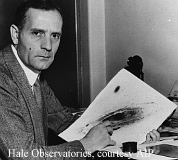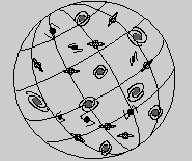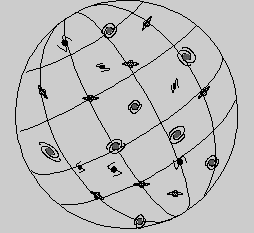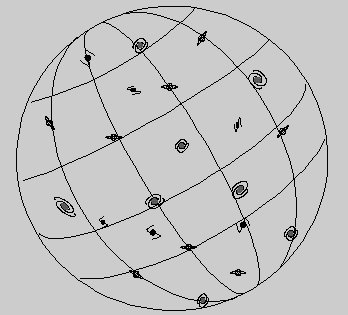There are several important historical threads in the development of modern cosmology. Controversy over the nature of "spiral nebulae" had persisted since the late 18th century, with one camp insisting they were external "universes," while their opponents were equally convinced that the spiral nebulae were localized clusters of stars within our Galaxy. An important early discovery was Shapley's determination of the size of the Milky Way Galaxy, and of our location within it. Shapley found the Milky Way to be much larger than previously believed, and on this basis he erroneously concluded that the spiral nebulae must be relatively nearby clusters. Shapley and Curtis participated in a famous debate in 1920 over the nature of the spiral nebulae, but insufficient data prevented a resolution of the puzzle. Finally, Hubble determined that the Andromeda Nebula (now known as the Andromeda Galaxy) was much too far to lie within the confines of the Milky Way; Hubble had discovered external galaxies. In the first quarter of the twentieth century, humanity's view of the cosmos leaped from a fairly limited realm of the Sun surrounded by an amorphous grouping of stars, to one in which the Milky Way is just a typical spiral galaxy in a vast universe filled with galaxies.
Not long after Hubble's discovery of external galaxies came his discovery of a linear relationship between their redshifts and their distances, a relationship known today as the Hubble Law. Determining the value of the constant of proportionality, the Hubble constant, remains an important research goal of modern astronomy. The Hubble "constant" is not really constant, because it can change with time, though at any given instant of cosmic time in a homogeneous, isotropic universe, it is the same at all spatial locations. The inverse of the Hubble constant, called the Hubble time, gives an estimate of the age of the universe.
The development of the theory of general relativity provided the framework in which Hubble's discovery could be understood. Einstein found that his equations would not admit a static, stable model of the universe, even with the addition of the "cosmological constant.". The timely discovery of the redshift-distance relationship provided evidence that the universe was not static, but was expanding. The Robertson-Walker metric is the most general metric for an isotropic, homogeneous universe that is also dynamic; i.e. it changes with time. An important parameter in this metric is the scale factor, the quantity which describes how lengths in the universe change with cosmic time. The scale factor can be used to derive the cosmological redshift, the change in wavelength of light as it traverses the universe.
 Edwin Hubble
Edwin Hubble

Consider a two-dimensional spherical surface upon which we have a collection of 2D galaxies. Notice the lines of latitude: these are our comoving coordinates. Now let's have this sphere expand a bit:

Notice that the galaxies stay the same size and in the same position relative to the lines of latitude and longitude (comoving coordinates stay constant). But because the sphere has expanded, there is now a greater distance between each galaxy. The further away two galaxies were at the start, the greater their separation now. This is the Hubble Law.

More expansion simply increases the effect. Everything scales up equally, all observers see a Hubble Law with galaxies appearing to move away from them. But no galaxy is truly at the center of this expansion. There is no center on the surface of the sphere. (Yes, there is a center of the sphere in the third dimension, but there is no requirement in geometry that such higher "embedding" dimensions exist. The 2D spherical surface is a perfectly consistent, self-contained geometric entity.)